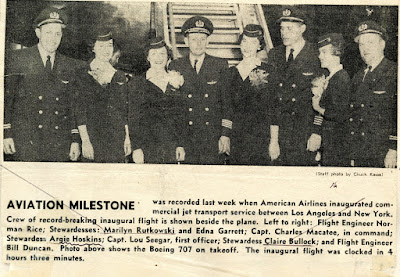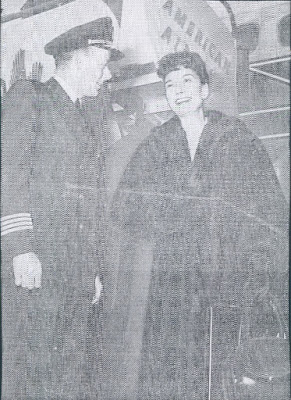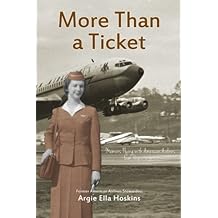AN EXCITING DAY AT THE SALT LAKE CITY INTERNATIONAL AIRPORT
On January 25, 2018, I will be celebrating the historical event that changed airline travel! I will be at the Salt Lake International airport, Terminal 2 from 8:30 am until 12:30 pm: location will be at the Weller Book Works. The store is after you go through security and before the escalator. This will be a fun book signing event.
https://www.amazon.com/More-Than-Ticket-American-Airlines
American Airlines, after years of preparation, we danced with joy as the jet was christened Flagship California. It was a day of adventure with Captain Macatee at the controls. Historical!
 |
| Captain Macatee |
 |
| Inaugural Flight crew January 25, 1959 |
 |
| Captain Macatee with Jane Wyman, actress, singer, and dancer for seven decades. |
 |
| Captain Macatee, Stewardess Argie, and Captain Szabo |
 |
| There was a time when our wings had our names on them and in front of the cabin we displayed a name plate. |
 |
| Argie with a current Flight Attendant and a current pilot for American Airlines. |
Jounal entry January 25, 1959:
Pat Brown, Red Moiser (an American Airlines Executive), President C. R. Smith, Miss Jane
Pat Brown, Red Moiser (an American Airlines Executive), President C. R. Smith, Miss Jane
Wyman, and Mr. and
Mrs. Hill plus others stroll through the plane.
Mrs. Brown christened the
plane, “Flagship
California,” with speeches by Governor Brown and
C. R. Smith.
Not only was the
event impressive, but Flagship California was graceful, sleek, and
absolutely gorgeous with open hospitality for all who entered her doors. In her
resplendent beauty she was far more than a ticket.
At this point Claire Bullock, who was my roommate and one of the stewardesses, was standing in the front of the craft greeting guests. She was from the South and a totally dedicated fan of Elvis Presley. As she was standing in front of the plane, Elvis’s agent handed her a photo of Elvis to accompany us on the first jet flight. He was in the army. Claire was thrilled. In different locations on the plane, bouquets of yellow and lavender flowers welcomed our guests. Oh yes, the stewardesses received orchids to wear. The entire flight was made up of very influential and successful people, newspaper people, and cameramen, plus other wonderful passengers. Passengers were milling from one cabin to the other, Mercury to Coach. It was like a press conference and confusing for me. The task at hand was to serve our passengers beverage and food with first class service in a very informal atmosphere as one big happy family. I gave Miss Wyman my flight topper to wear that being the dress we wore during the food service. Everyone was having a grand time up in the “dream of sunshine and clouds.” It was a magnificent experience and lots of hard work.
At this point Claire Bullock, who was my roommate and one of the stewardesses, was standing in the front of the craft greeting guests. She was from the South and a totally dedicated fan of Elvis Presley. As she was standing in front of the plane, Elvis’s agent handed her a photo of Elvis to accompany us on the first jet flight. He was in the army. Claire was thrilled. In different locations on the plane, bouquets of yellow and lavender flowers welcomed our guests. Oh yes, the stewardesses received orchids to wear. The entire flight was made up of very influential and successful people, newspaper people, and cameramen, plus other wonderful passengers. Passengers were milling from one cabin to the other, Mercury to Coach. It was like a press conference and confusing for me. The task at hand was to serve our passengers beverage and food with first class service in a very informal atmosphere as one big happy family. I gave Miss Wyman my flight topper to wear that being the dress we wore during the food service. Everyone was having a grand time up in the “dream of sunshine and clouds.” It was a magnificent experience and lots of hard work.
A
memorable
highlight of the day was when I met President C. R. Smith as he walked
the aisle during the flight. One could feel the strength of his
character. He had the skill of
looking you in the eye and connecting with you on a level which left
you feeling like you were important to American Airlines. I knew that he
appreciated me as a stewardess.
I remember giving
Jane Wyman my flight topper to wear, and she was filmed while she had
it on. Flight toppers were worn while serving a meal. We had our choice as a
crew to either wear or not wear the topper. It made a more appropriate dress
for the food service if we did, though. One of the important reasons for the
cover-up was that it kept the uniform clean. It was flattering to me that Miss
Wyman wore the same size as I wore. She was very pleasant to be around. In the
movie Three Guys Named Mike, she played the part of an American Airline
stewardess.
On the passenger list, Mr. G. Wright was listed as 89 years old; I
think that made him the oldest
person on the inaugural flight. Mr. and Mrs. L. Barnett brought their little
son who was two and a half years old, making him the youngest passenger.
Also on the flight
was Dr. Arthur L. Klein, an aeronautical engineer and legend designer. Dr.
Clark Millikan was also on board. He was one of the nation’s foremost
pioneers in aerospace research and development. He was also a pioneer in
the development of multi-engine, high-altitude airplanes, jet
propulsion,
and
guided missiles. I had this gentleman on an earlier flight, and I had
enjoyed his friendliness and his usual enthusiasm for his projects. In
the 1950s a new facet of
aeronautics came into view with the ideas of satellites and spacecraft,
and he
worked right at the forefront of thes ideas. I had met him a second time
on a
PR assignment, and now this flight was my third meeting with him. It was
always exciting to meet people over and over.
We arrived in New
York 4 hours and 3 minutes later.(It takes over 5 hours) The 707 took more fuel and went faster. A band was
playing when we opened the door and bright lights were shining with people taking pictures. Our
debriefing after the flight was interesting. We
are helping work out all the things which need to
be changed with the Boeing 707 stewardess
procedural operations. We were so tired, Claire and I
said, “Never again.”
The flight was
overwhelming; however, our training kept us calm and poised. We had the
knowledge to be self-sufficient and to make decisions that affected our
passengers. In a crisis we could rise above the everyday requirements of passenger
service. We were tired, yes, but we were prepared. After a good night’s
sleep, we put in our bids to work the 707 flights again and again.
Not only was it a
privilege to have the greatest passengers walk through our American
Airlines doors, but we also had crews who were marvelously skilled behind the
wheels of our fantastic aircraft. The captain of our flight was Charles Macatee. He
had years of experience flying.
Frank Brady’s book: A Singular View, begins with just one of Captain Macatee’s experiences—successfully landing a hit plane in the crash that cost Brady his eye. Brady writes:
Frank Brady’s book: A Singular View, begins with just one of Captain Macatee’s experiences—successfully landing a hit plane in the crash that cost Brady his eye. Brady writes:
"I
have no memory of
being hit. I recall only a dazed awareness that something was wrong,
very wrong . . . that [Charles Macatee] was swinging our plane into
position
for a landing . . . asking the tower for runway lights . . .calling for
an
ambulance to meet the plane.
Then Tom Wright, the
third man aboard, was helping me out of the cockpit, where I had been
flying copilot, and onto a couch so that he could take my place and
assist in the landing. . . .
Our plane, a research DC–3, had been on the last leg of a flight
from Chicago via Washington that
April evening. We’d been skimming over Long Island after sunset
and were preparing to land at Grumman Field when the craft was
struck. Captain Macatee (who later was to pilot the first scheduled jetliner
across America) had no idea what had hit us until after landing, when he
found a five-pound mallard duck in the cockpit."
It was little wonder
why American Airlines chose Charles Macatee to captain the inaugural
flight. The Astrojet News
published an interview with Captain Macatee 10 years after the inaugural
flight. In it, he says that piloting this flight “was and had to be his biggest
thrill in 30 years of flying.”
The preparations had
begun years before. “Paper jets” had begun “flying” daily New York–Los
Angeles and Chicago–Dallas trips in July 1958. But the big moment
was 8:45 a.m. Pacific Coast Time Sunday, Jan. 25, 1959. With Capt. Macatee
at the controls, First Officer (now captain) Lou Szabo beside him, and 112
passengers aboard, American’s first Jet Flagship lifted off Runway 25L, at Los
Angeles International Airport and headed for New York.
FIRST TRANSCON FLIGHT
It was commercial
aviation’s first transcontinental jet flight, a flight that brought east and
west coasts three hours closer together and revolutionized an airline, an
industry and the nation’s transportation system.
“We got off 20
minutes late because of the ceremonies at Los Angeles. But we were
fortunate enough to catch tailwinds that at times were in excess of 150 knots. We
arrived at New York on schedule, exactly four hours and 3 minutes after
takeoff.” . . .
Hundreds of people,
including a 25-piece brass band, turned out at Idlewild to welcome
the first transcon jet (more than 25,000 had seen it off at LAX).
Newsmen, government officials and movie stars were aboard, including actress
Jane Wyman (“who for some reason I kept calling Mrs. Lyman,” Captain
Macatee recalled).
C. R. Smith, also
aboard, told AAers in a special issue of Flagship News to “take a bow to
history, for you are a part of it today. The piston-engined airplane will retain
our affection, for it has done so much for us and for air transportation.
Today, we have a new area of expectation, for the bright promise of what the
turbine-powered airport will bring lies ahead of us.”
Astrojet News vol.
24, no. 2, January 27, 1969. Photo courtesy of Beth Macatee Snyder.
In the article Captain Macatee also reflected upon the historical
significance of this first
transcontinental jet flight. He and Captain H. C. Smith, who flew the return trip, had
flown the 707 without passengers for about 200 hours before this historical flight
with passengers. The article states that for Captain Macatee, this flight was “biggest
thrill in 30 years of flying,” and Captain Macatee concluded his comments by
saying that while he had many special memories of flying “those four hours
three minutes were the big ones for me. They always will be.”
My friends who are involved in the business of flying, these four hours and three minutes were big ones for me also and they always will be!
My friends who are involved in the business of flying, these four hours and three minutes were big ones for me also and they always will be!













